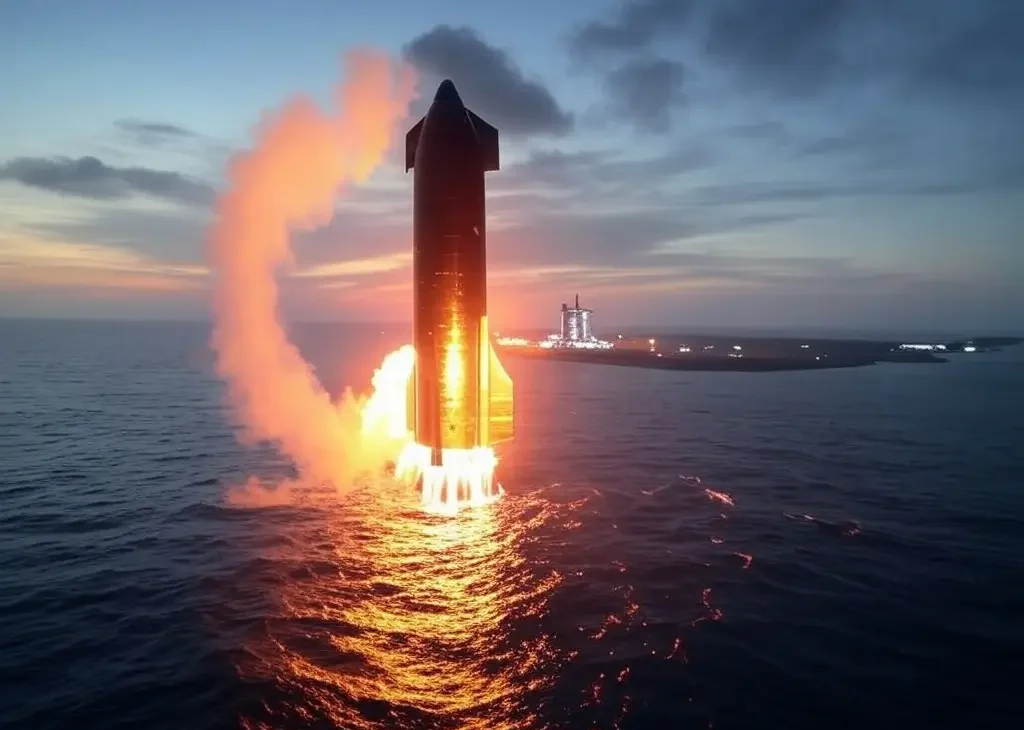
Key Points
- SpaceX is advancing its Starship program, with the latest test flight on March 7, 2025, showing partial success by catching the booster but losing the upper stage due to engine issues.
- The Starlink project has over 7,000 satellites in orbit, aiming for 42,000, and recently completed a direct-to-cell constellation in December 2024, serving over 4 million subscribers.
- SpaceX is a key partner in NASA’s Artemis program, developing Starship for lunar landings, with Artemis III planned for the first crewed mission.
- Reusable rocket technology, including successful booster catches, is reducing launch costs, potentially transforming space access.
SpaceX’s Latest Trends
SpaceX, founded by Elon Musk in 2002, continues to push the boundaries of space exploration with innovative projects that capture global attention. As of March 2025, the company is making significant strides in its Starship program, expanding its Starlink satellite internet network, and playing a pivotal role in NASA’s Artemis lunar missions. Additionally, advancements in reusable rocket technology are lowering costs and increasing launch frequency, setting the stage for future Mars colonization and beyond.
Starship Program
The Starship program aims to create a fully reusable spacecraft capable of carrying crew and cargo to Earth orbit, the Moon, and Mars. With a lift capacity of over 100 metric tons to low Earth orbit, it’s designed to be the world’s most powerful launch vehicle. The recent eighth test flight on March 7, 2025, from Boca Chica, Texas, showcased progress: the Super Heavy booster was successfully caught by “chopsticks” mechanical arms, marking a third consecutive successful catch. However, the upper stage faced multiple engine shutdowns, spinning out of control and breaking apart, highlighting ongoing challenges in achieving full reusability.
SpaceX’s plans include establishing a manufacturing facility at Kennedy Space Center, Florida, with a “Gigabay” facility expected by late 2026, to support increased launch rates. This facility, spanning 815,000 square feet, will enable the company to build a fleet for initial flights, potentially transforming lunar and Mars missions.
Starlink
Starlink, SpaceX’s satellite internet constellation, is revolutionizing global broadband access, especially in remote areas. As of February 2025, it has over 7,000 satellites in orbit, with 7,052 operational, and aims for a megaconstellation of up to 42,000. The project recently completed its first direct-to-cell constellation in December 2024, enhancing connectivity for cellular devices. With over 4 million subscribers as of September 2024, Starlink is achieving stable 20-millisecond median latency and minimal packet loss, but it faces concerns from astronomers about light pollution and orbital collision risks.
Role in NASA’s Artemis Program
SpaceX is a critical partner in NASA’s Artemis program, which seeks to return humans to the Moon and establish a sustainable presence. The company is developing Starship as the human landing system (HLS) for Artemis III and IV, aiming to land the first woman and first person of color on the lunar surface. The third integrated flight test in March 2024 was a milestone, bringing the program closer to its goal of crewed lunar landings by 2027-28, with an unpiloted Starship moon landing planned prior.
Reusable Rocket Technology
SpaceX’s reusable rocket technology, particularly with Falcon 9, has already reduced launch costs by landing and reusing first stages. The Starship program takes this further, with the recent successful booster catch using “chopsticks” on March 7, 2025, demonstrating full reusability potential. This innovation could lower costs dramatically, making space travel more accessible and supporting mega constellations like Starlink.
Survey Note: In-Depth Analysis of SpaceX Trends as of March 2025
SpaceX’s trajectory in early 2025 reflects a company at the cusp of transforming space exploration and commercial spaceflight. This section delves into detailed developments, drawing from recent announcements, test flights, and industry analyses, ensuring a comprehensive overview for both casual readers and space enthusiasts.
Starship Program: Objectives, Progress, and Recent Challenges
The Starship program, encompassing the Super Heavy booster and Starship upper stage, is designed for fully reusable spaceflight, targeting Earth orbit, lunar, and Mars missions. Its lift capacity exceeds 100 metric tons to low Earth orbit, positioning it as a cornerstone for future exploration. The program’s objectives include supporting NASA’s Artemis missions and enabling Mars colonization, with Elon Musk envisioning a multi-planetary future.
Recent progress includes multiple test flights, with the eighth flight on March 7, 2025, launched at 6:30 p.m. EST from Boca Chica, Texas. This flight utilized 33 methane-fueled Raptor engines for the booster, generating up to 16 million pounds of thrust, and six Raptor engines for the 160-foot-tall, 30-foot-diameter upper stage. The mission aimed for a sub-orbital trajectory, planning to deploy four simulated Starlink satellites, test in-space engine restarts, and conduct heat shield tests, with a soft landing targeted in the Indian Ocean near Australia.
However, the flight faced significant challenges: at 8 minutes 20 seconds, four of the six upper stage engines shut down, causing the spacecraft to spin out of control and break apart in a debris shower. Contact was lost, marking the second destructive breakup in a row, following the seventh flight’s failure in January 2025 due to ruptured propellant lines. Despite this, the first-stage booster’s successful capture by “chopsticks” mechanical arms was a highlight, achieving a third consecutive catch. This partial success underscores SpaceX’s iterative approach, with the Federal Aviation Administration likely to order a failure investigation.
Future plans include expanding facilities at Kennedy Space Center, with a “Gigabay” facility (380 feet tall, 46.5 million cubic feet, 815,000 square feet workspace) expected by late 2026. SpaceX intends to transport completed Super Heavy boosters and Starship upper stages via barge to Florida, building a fleet for initial flights. This expansion aims to support NASA’s Artemis program, where Starship will carry astronauts to the Moon’s south pole, targeting the first woman and next man for 2027-28, with an unpiloted landing prior.
| Details of the Launch | Information |
|---|---|
| Date | March 7, 2025 |
| Launch Site | SpaceX’s Boca Chica, Texas |
| Rocket | Super Heavy-Starship |
| Test Flight Number | Eighth test flight |
| Liftoff Time | 6:30 p.m. EST |
| First Stage Engines | 33 methane-fueled Raptor engines |
| First Stage Thrust | Up to 16 million pounds |
| Upper Stage Engines | 6 Raptor engines |
| Upper Stage Height | 160 feet |
| Upper Stage Diameter | 30 feet |
| First Stage Booster Capture | Third successful booster catch in a row, using “chopsticks” mechanical arms |
| Previous Failure Reference | Seventh integrated flight test (IFT) in January, fire due to ruptured propellant lines, self-destruct triggered after 8 minutes 20 seconds |
| Current Failure | Multiple upper stage engine shutdowns (4 of 6 engines at 8 minutes 20 seconds), spacecraft spun out of control, broke apart, debris shower, contact lost |
| Planned Trajectory | Sub-orbital, deployment of 4 simulated Starlink satellites, in-space Raptor engine restart, heat shield tests, soft landing in Indian Ocean near Australia |
| Investigation | Federal Aviation Administration likely to order failure investigation due to second destructive breakup |
| Related Programs | NASA Artemis program, Starship to carry astronauts to moon’s south pole, first woman and next man targeted for 2027-28, unpiloted Starship moon landing prior |
| Future Facilities | Kennedy Space Center, Florida: “Gigabay” facility (380 feet tall, 46.5 million cubic space, 815,000 sq ft workspace, completion by end of 2026), additional Starship manufacturing facility planned |
| Additional Notes | SpaceX plans to transport completed Super Heavy boosters and Starship upper stages from Starbase via barge to build fleet in Florida for initial flights |
Starlink Project
Starlink, launched in 2015, is SpaceX’s initiative to provide low-cost, high-speed internet via a satellite constellation in low Earth orbit. As of February 27, 2025, it comprises 7,086 satellites, with 7,052 operational, according to astronomer Jonathan McDowell’s tracking (Starlink satellites: Facts, tracking and impact on astronomy | Space). The project aims for 42,000 satellites, with the current V2 version weighing 1,760 lbs at launch, nearly three times heavier than earlier models.
Recent developments include completing the first direct-to-cell constellation in December 2024, launched from California, enhancing mobile connectivity (SpaceX completes 1st Starlink direct-to-cell constellation with launch from California | Space). Starlink reached over 4 million subscribers by September 2024, up from 1 million in December 2022, with revenues reported at $1.4 billion in 2022, turning a small profit in 2023 (Starlink – Wikipedia). Engineering efforts have focused on reducing latency to 20 milliseconds and minimizing packet loss, as noted in a March 2024 update (Starlink | Updates).
However, the project’s scale raises concerns. Astronomers worry about bright satellites interfering with observations, and spaceflight safety experts highlight Starlink as the number one collision hazard in Earth’s orbit. SpaceX is addressing these issues, collaborating with the National Radio Astronomy Observatory to mitigate interference near radio telescopes.
NASA’s Artemis Program
SpaceX’s role in NASA’s Artemis program is pivotal, focusing on developing Starship as the human landing system (HLS) for lunar missions. The program aims to return humans to the Moon, targeting the south pole region, with Artemis III planned as the first crewed landing, potentially in 2027-28. This mission will include the first woman and first person of color on the lunar surface, building on the uncrewed Artemis I test and crewed Artemis II flight test (Artemis program – Wikipedia).
The third integrated flight test of Starship in March 2024 was a milestone, demonstrating the Super Heavy booster and upper stage’s capabilities for NASA’s HLS needs (NASA Artemis Mission Progresses with SpaceX Starship Test Flight – NASA). Artemis III will involve four astronauts launching on NASA’s Space Launch System rocket in Orion, docking with Starship in lunar orbit for the descent, with a 30-day mission duration. This collaboration leverages SpaceX’s cost-effective solutions and NASA’s extensive experience, fostering a public-private partnership for deep space exploration.
Reusable Rocket Technology
SpaceX’s reusable rocket technology, initiated with Falcon 9, has revolutionized launch economics by landing and reusing first stages. The company’s focus on reusability extends to Starship, aiming for both booster and upper stage recovery. The recent March 7, 2025, launch achieved a third consecutive successful booster catch using “chopsticks” mechanical arms, a method that could significantly reduce launch costs by eliminating the need for separate landing infrastructure (SpaceX reusable launch system development program – Wikipedia).
This technology supports high launch cadences, crucial for Starlink deployments and government contracts, with SpaceX leading global launches in 2024 with 138 missions, 134 by Falcon 9 (Launching Into the Future of Satellite Technology with SpaceX’s Reusable Rockets). The Raptor engines, using liquid oxygen and methane, enhance reusability, with research suggesting potential for extending lifespans and reducing maintenance costs (Boosting rocket reliability at the material level | MIT News | Massachusetts Institute of Technology).
Other Developments
Beyond core projects, SpaceX has expanded through partnerships. The Starshield program, announced in December 2022, integrates military and government payloads on Starlink-derived buses, with the Space Development Agency as a key customer for missile defense systems (SpaceX – Wikipedia). In June 2024, SpaceX introduced the “Starlink Mini” antenna for mobile use, priced at $599, offering over 100 Mbit/s download speeds and lower power consumption, half the size and one-third the weight of the standard model.
Collaborations include working with NASA on thermal measurements during Starship reentry and partnering with startups like Vast for commercial space stations, with Haven-1 planned for launch by late 2025 (Seven US Companies Collaborate with NASA to Advance Space Capabilities – NASA, Space startup partners with SpaceX to launch commercial space station | Reuters). These efforts underscore SpaceX’s role in fostering a commercial space economy.
Future Prospects
Looking forward, SpaceX’s trajectory suggests increased launch frequencies, with plans for 25 Starship launches in 2025, supporting both Starlink expansion and Artemis missions. The company’s focus on Mars colonization remains, with Starship’s reusability and high payload capacity seen as critical. However, challenges like regulatory hurdles, environmental concerns, and technical failures, as seen in the recent Starship test, will require continuous innovation and collaboration.
This comprehensive analysis highlights SpaceX’s dynamic role in shaping the future of space exploration, balancing technological breakthroughs with global connectivity and lunar ambitions.




hello
gnsmdu